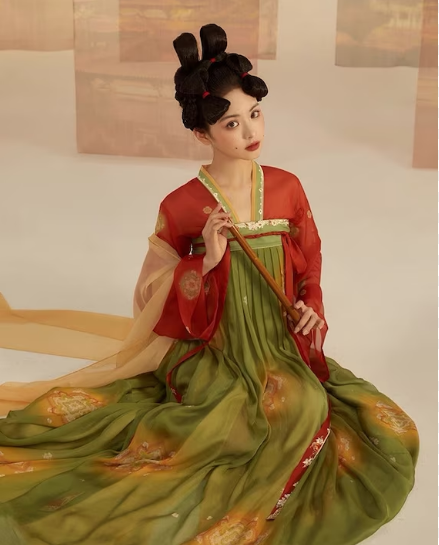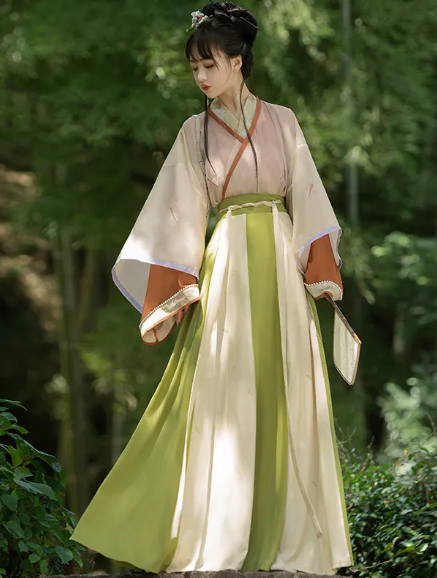Overview of Hanfu Variations by Region
Hanfu, the traditional clothing of the Han Chinese, has evolved uniquely across various regions of China, mirroring the diversity of Chinese culture. Each region, influenced by its climate, local customs, and historical events, has developed distinctive Hanfu styles. This overview delves into the specific characteristics of Hanfu from Northern, Southern, Eastern, and Western China, highlighting how geography and culture have shaped these variations.
Northern China Hanfu Styles
In the colder northern regions, Hanfu styles prioritize warmth and practicality. The robes are typically made of heavier fabrics like wool or thick silk. The designs feature high collars and multiple layers, often adorned with intricate patterns and embroidery. The influence of nomadic cultures from the steppes is evident in the styles, introducing elements like fur lining and broader sleeves for better insulation. This adaptation reflects the pragmatism of the northern people, who value functionality in their garments due to the harsh climate.

Southern China Hanfu Variations
Contrastingly, the Hanfu in Southern China, a region with a warmer and more humid climate, leans towards lighter materials like fine silk and gauze. The styles here are more flowing and airy, allowing for better ventilation and ease of movement. The colors are often brighter, with floral patterns being a common motif, reflecting the lush landscapes of the south. This region’s proximity to the sea also influences its Hanfu designs, with elements like wave patterns and sea creature motifs occasionally incorporated.
Eastern and Western China
Eastern China, known for its cultural and economic prosperity, especially during periods like the Tang and Song dynasties, showcases Hanfu styles that are elegant and sophisticated. The use of luxurious fabrics and vibrant colors is common, reflecting the region’s affluence. Western China, on the other hand, has Hanfu styles influenced by its rugged terrain and diverse ethnic cultures. The garments here are often sturdier, with more subdued colors, and feature designs that embody the confluence of various cultural influences, including Tibetan and Central Asian.
To provide a comprehensive comparison of these regional Hanfu styles, the following table summarizes their key characteristics across various aspects:
| Feature | Northern China | Southern China | Eastern China | Western China |
|---|---|---|---|---|
| Fabric Type | Wool, Thick Silk | Fine Silk, Gauze | Luxurious Fabrics | Sturdy, Subdued Fabrics |
| Design Elements | High Collars, Layers | Flowing, Airy | Elegant, Vibrant | Rugged, Diverse |
| Climatic Adaptation | Warmth, Insulation | Ventilation, Lightness | Sophistication | Durability |
| Cultural Influences | Nomadic, Practical | Floral, Sea Motifs | Affluence, Elegance | Ethnic Diversity |
| Common Patterns/Motifs | Intricate Embroidery | Floral Patterns | Vibrant Colors | Subdued, Ethnic Motifs |
This table not only highlights the diversity of Hanfu styles across different regions of China but also illustrates how regional characteristics and cultural influences play a pivotal role in shaping traditional attire.
Historical Context of Regional Hanfu Styles
The Hanfu, as a significant element of Chinese cultural identity, has a rich history deeply intertwined with China’s dynastic changes and cultural exchanges. This historical context sheds light on the evolution of Hanfu styles, revealing how each dynasty and cultural interaction has left an indelible mark on this traditional attire.
Dynastic Influences on Regional Hanfu
During the Han Dynasty, Hanfu became a symbol of cultural unity, with styles emphasizing simplicity and modesty. As time progressed, each dynasty brought its unique aesthetic preferences. For instance, the Tang Dynasty saw a fusion of Hanfu styles with influences from the Silk Road, introducing vibrant colors and luxurious fabrics. The Song Dynasty emphasized elegance and refinement, leading to more subdued and sophisticated designs. In contrast, the Ming Dynasty revived traditional Hanfu styles, focusing on cultural heritage preservation, which led to a resurgence of classical designs, particularly in Eastern and Southern China.
Cultural Interactions and Hanfu Evolution
Hanfu also evolved through cultural interactions with neighboring regions and peoples. The Northern styles, for instance, incorporated elements from nomadic tribes, such as fur linings and broader sleeves, as a practical response to the colder climate and cultural exchanges with northern ethnic groups. Southern Hanfu, influenced by maritime trade, often featured motifs inspired by sea voyages and foreign cultures. In Western China, the Silk Road played a pivotal role, introducing Central Asian patterns and styles, blending them seamlessly with traditional Hanfu, thus creating a unique fusion that reflected the region’s diverse cultural landscape.
These historical and cultural influences not only shaped the stylistic evolution of Hanfu but also mirrored the broader societal changes in China. The Hanfu’s evolution is a testament to China’s rich history, marked by periods of cultural flourishing and exchange, showcasing the country’s ability to both preserve and adapt its traditions in the face of changing times and influences.
Key Elements Differentiating Regional Hanfu
The distinctiveness of regional Hanfu styles lies in their varied fabric choices, color schemes, patterns, and adaptations in cut and fit. These elements not only reflect the unique aesthetics of each region but also their responses to local environmental and cultural conditions.
Fabric and Material Choices
In Northern China, the Hanfu often uses heavier fabrics like brocade and wool to provide warmth in colder climates. These materials are robust, offering durability and comfort during long winters. In contrast, Southern regions favor lighter materials such as silk and linen, suitable for their humid and warmer climate. These fabrics are known for their breathability and elegant drape, enhancing the wearer’s comfort and grace. Eastern regions, historically affluent, often choose luxurious fabrics like damask and fine silk, showcasing their wealth and status. Western regions, influenced by their rugged terrain and diverse culture, prefer sturdy yet comfortable materials like cotton and hemp, which are suitable for their varied landscape.
Color Schemes and Patterns in Different Regions
Color and pattern choices in Hanfu vary significantly across regions. Northern Hanfu often features darker, more subdued colors, reflecting the practical needs of a colder climate. Southern Hanfu, on the other hand, displays a vibrant palette with lush, bright colors, mirroring the region’s natural beauty. Eastern Hanfu is known for its sophisticated use of color, often employing pastel shades and intricate patterns to reflect elegance. Western Hanfu, influenced by various ethnic cultures, incorporates bold and diverse patterns, often with symbolic meanings, reflecting the region’s rich cultural tapestry.
Cut and Fit(Regional Adaptations)
The cut and fit of Hanfu also differ regionally, adapting to local needs and aesthetics. In the North, Hanfu tends to have a looser fit with broader sleeves, providing ease of movement and space for layering in cold weather. The South prefers a more fitted silhouette, highlighting the wearer’s grace and the fluidity of the lighter fabrics. Eastern Hanfu often features complex layering and structured cuts, emphasizing formality and sophistication. In contrast, Western Hanfu blends functionality with comfort, often having a relaxed fit suitable for a more rugged lifestyle.
These key elements — fabric, color, pattern, cut, and fit — not only distinguish Hanfu styles from different regions but also tell a story of the people and their lives, influenced by their local environment, climate, and cultural heritage. Each regional variation of Hanfu is a unique expression of Chinese culture, beautifully encapsulating the diversity within unity that characterizes the vast expanse of China.

Comparative Analysis of Hanfu Across Regions
The Hanfu, with its deep historical roots and regional variations, presents a fascinating study of cultural diversity within China. This comparative analysis explores the common threads and divergences among regional Hanfu styles, highlighting case studies and the modern revival of these traditional garments.
Common Threads and Divergences
Despite regional differences, Hanfu styles share common threads such as the emphasis on flowing lines and the integration of cultural symbolism. However, divergences are pronounced. For example, Northern Hanfu’s practicality contrasts sharply with Southern Hanfu’s emphasis on aesthetics. Eastern Hanfu’s sophistication and luxurious fabrics set it apart from the Western Hanfu, which is more rugged and influenced by a blend of ethnic cultures. These variations not only reflect the geographical and climatic differences of each region but also their unique historical and cultural backgrounds.
Case Studies(Regional Hanfu in Historical Records)
Historical records offer rich insights into regional Hanfu styles. For instance, the Tang Dynasty’s capital, Chang’an (now Xi’an), was a melting pot of cultures, as seen in its vibrant, cosmopolitan Hanfu styles. The Ming Dynasty’s records depict the resurgence of traditional Hanfu, especially in the Eastern regions, where there was a conscious effort to revive classical styles. These case studies not only illuminate the historical context of Hanfu but also showcase the evolving nature of this traditional attire across different dynasties and regions.
Modern Interpretations and Revival of Regional Styles
In recent years, there has been a significant revival and reinterpretation of regional Hanfu styles, often blending traditional designs with modern aesthetics. For example, designers are reimagining Northern Hanfu with contemporary fabrics while retaining traditional cuts. In the South, modern Hanfu often incorporates innovative designs while preserving the classic elegance and fluidity of traditional styles. This revival not only pays homage to the rich heritage of Hanfu but also adapts it to contemporary fashion sensibilities, making it relevant to a new generation of admirers.
Through this comparative analysis, it becomes evident that Hanfu is not just a traditional garment but a living, evolving expression of Chinese culture. Each region’s Hanfu style tells its own story, reflecting the diverse tapestry of China’s long and rich history.







